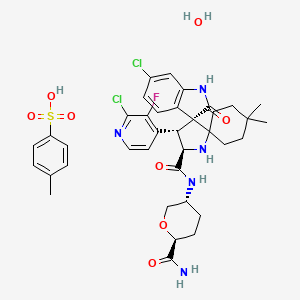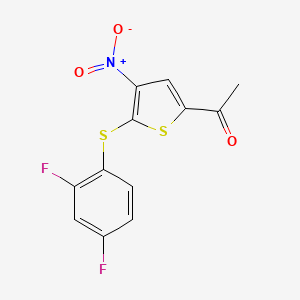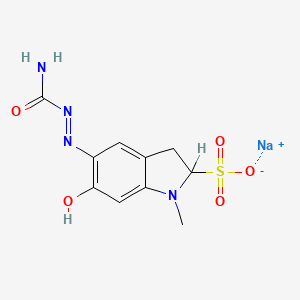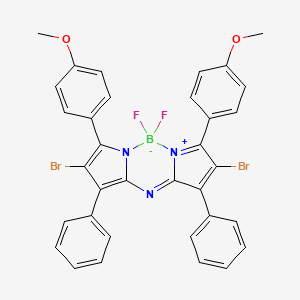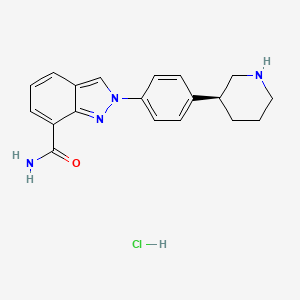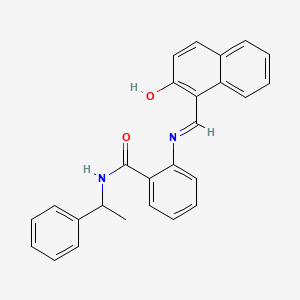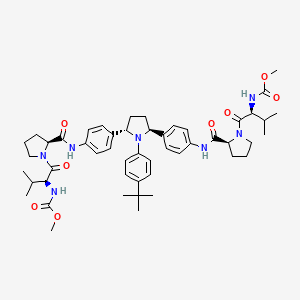
Ombitasvir
Vue d'ensemble
Description
Ombitasvir est un médicament antiviral utilisé pour le traitement de l'infection par le virus de l'hépatite C (VHC). Il s'agit d'un antiviral à action directe qui inhibe la protéine non structurale 5A (NS5A), essentielle à la réplication virale et à l'assemblage des virions . L'this compound est couramment utilisé en association avec d'autres agents antiviraux tels que le paritaprevir, le ritonavir et le dasabuvir pour obtenir une réponse virologique durable (RVS) chez les patients atteints d'hépatite C chronique .
Applications De Recherche Scientifique
Ombitasvir has several scientific research applications, including:
Medicine: this compound is primarily used in the treatment of chronic hepatitis C infection. .
Chemistry: The synthesis and analysis of this compound have contributed to the development of advanced analytical techniques and methodologies for studying complex organic compounds
Mécanisme D'action
Target of Action
Ombitasvir is a direct-acting antiviral agent that primarily targets the nonstructural protein 5A (NS5A) of the Hepatitis C Virus (HCV) . NS5A is a multifunctional protein that plays crucial roles in viral replication and assembly .
Mode of Action
This compound acts by inhibiting NS5A, a protein essential for viral replication and virion assembly . By binding to NS5A, this compound disrupts the formation of the replication complex, thereby preventing the replication of the HCV RNA genome .
Biochemical Pathways
The inhibition of NS5A by this compound disrupts the HCV replication cycle. This disruption prevents the production of new viral particles, thereby reducing the viral load in patients with HCV infection . The exact biochemical pathways affected by this compound are still under investigation.
Pharmacokinetics
This compound displays linear pharmacokinetics with minimal accumulation . It is predominantly metabolized by amide hydrolysis followed by oxidative metabolism . This compound is a substrate of P-glycoprotein, a protein that pumps foreign substances out of cells . It is eliminated via metabolism and biliary excretion, with a negligible amount of unchanged drug excreted in urine . The elimination half-life of this compound is approximately 21 to 25 hours .
Result of Action
The result of this compound’s action is a significant reduction in HCV viral load, leading to a sustained virologic response (SVR) after 12 weeks of daily therapy . SVR and eradication of HCV infection are associated with significant long-term health benefits, including reduced liver-related damage, improved quality of life, reduced incidence of hepatocellular carcinoma, and reduced all-cause mortality .
Analyse Biochimique
Biochemical Properties
Ombitasvir is a potent inhibitor of NS5A, a protein essential for viral replication and virion assembly . It displays linear pharmacokinetics over the dose range evaluated . This compound is predominantly metabolized by amide hydrolysis followed by oxidative metabolism, and has low potential for drug interactions .
Cellular Effects
This compound, as part of combination therapy, is used to treat chronic Hepatitis C, an infectious liver disease caused by infection with Hepatitis C Virus (HCV) . It acts by inhibiting the HCV protein NS5A, which is essential for viral replication and virion assembly .
Molecular Mechanism
The molecular mechanism of this compound involves the inhibition of the HCV protein NS5A . NS5A is a protein that is essential for viral replication and virion assembly. By inhibiting this protein, this compound prevents the virus from replicating and assembling new virions .
Temporal Effects in Laboratory Settings
In laboratory settings, this compound has shown to be effective in achieving a sustained virologic response (SVR) after 12 weeks of daily therapy . The treatment with this compound is associated with very minimal side effects, with the most common being headache and fatigue .
Metabolic Pathways
This compound is mainly metabolized by amide hydrolysis followed by CYP2C8-mediated oxidative metabolism . The drug is mainly excreted in the feces (90.2%) with very little excreted in the urine (1.91%) .
Transport and Distribution
This compound displays high plasma protein binding (~99.9%) and has an apparent volume of distribution of 173 liters . The drug is mainly excreted in the feces (90.2%) with very little excreted in the urine (1.91%) .
Subcellular Localization
Given its mechanism of action, it can be inferred that this compound likely interacts with the HCV NS5A protein within the host cell where the viral replication and assembly occur .
Méthodes De Préparation
Voies de synthèse et conditions réactionnelles
La synthèse de l'ombitasvir implique plusieurs étapes, notamment la formation d'intermédiaires clés et leur couplage ultérieurLes conditions réactionnelles impliquent souvent l'utilisation de solvants organiques, de catalyseurs et de réactifs tels que l'acétonitrile, le tampon phosphate et l'acétate d'ammonium .
Méthodes de production industrielle
En production industrielle, l'this compound est synthétisé en utilisant des procédés chimiques à grande échelle qui garantissent un rendement et une pureté élevés. Le processus implique l'optimisation des conditions réactionnelles, des étapes de purification et des mesures de contrôle qualité afin de répondre aux normes réglementaires. La chromatographie liquide haute performance (HPLC) et la chromatographie liquide couplée à la spectrométrie de masse en tandem (LC-MS/MS) sont des techniques analytiques couramment utilisées pour surveiller la synthèse et garantir la qualité du produit final .
Analyse Des Réactions Chimiques
Types de réactions
L'ombitasvir subit plusieurs types de réactions chimiques, notamment :
Substitution : La synthèse de l'this compound implique des réactions de substitution pour introduire divers groupes fonctionnels sur le cycle pyrrolidine.
Réactifs et conditions courantes
Les réactifs courants utilisés dans la synthèse et les réactions de l'this compound comprennent l'acétonitrile, le tampon phosphate, l'acétate d'ammonium et divers solvants organiques. Les conditions réactionnelles sont soigneusement contrôlées pour obtenir les transformations chimiques souhaitées et garantir la stabilité du composé .
Principaux produits formés
Les principaux produits formés à partir des réactions impliquant l'this compound comprennent ses métabolites actifs, qui conservent l'activité antivirale et contribuent à l'effet thérapeutique global .
Applications de la recherche scientifique
L'this compound a plusieurs applications de recherche scientifique, notamment :
Médecine : L'this compound est principalement utilisé dans le traitement de l'infection chronique par le virus de l'hépatite C. .
Chimie : La synthèse et l'analyse de l'this compound ont contribué au développement de techniques analytiques avancées et de méthodologies pour l'étude de composés organiques complexes
Mécanisme d'action
L'this compound exerce ses effets antiviraux en inhibant la protéine non structurale 5A (NS5A) du virus de l'hépatite C. La NS5A est essentielle à la réplication et à l'assemblage viraux, et son inhibition perturbe le cycle de vie viral, ce qui entraîne une réduction de la charge virale . L'this compound se lie à la NS5A et empêche son interaction avec d'autres composants viraux et cellulaires hôtes, inhibant ainsi la réplication du virus .
Comparaison Avec Des Composés Similaires
L'ombitasvir fait partie d'une classe d'antiviraux à action directe connus sous le nom d'inhibiteurs de la NS5A. Des composés similaires dans cette classe comprennent :
Ledipasvir : Un autre inhibiteur de la NS5A utilisé en association avec le sofosbuvir pour le traitement de l'hépatite C.
Daclatasvir : Un inhibiteur de la NS5A utilisé en association avec d'autres agents antiviraux pour le traitement de l'hépatite C.
Elbasvir : Un inhibiteur de la NS5A utilisé en association avec le grazoprevir pour le traitement de l'hépatite C.
Comparé à ces composés similaires, l'this compound est unique dans sa combinaison avec le paritaprevir, le ritonavir et le dasabuvir, ce qui fournit un régime antiviral complet avec une grande efficacité et des effets secondaires minimes .
Propriétés
IUPAC Name |
methyl N-[(2S)-1-[(2S)-2-[[4-[(2S,5S)-1-(4-tert-butylphenyl)-5-[4-[[(2S)-1-[(2S)-2-(methoxycarbonylamino)-3-methylbutanoyl]pyrrolidine-2-carbonyl]amino]phenyl]pyrrolidin-2-yl]phenyl]carbamoyl]pyrrolidin-1-yl]-3-methyl-1-oxobutan-2-yl]carbamate | |
|---|---|---|
| Source | PubChem | |
| URL | https://pubchem.ncbi.nlm.nih.gov | |
| Description | Data deposited in or computed by PubChem | |
InChI |
InChI=1S/C50H67N7O8/c1-30(2)42(53-48(62)64-8)46(60)55-28-10-12-40(55)44(58)51-35-20-14-32(15-21-35)38-26-27-39(57(38)37-24-18-34(19-25-37)50(5,6)7)33-16-22-36(23-17-33)52-45(59)41-13-11-29-56(41)47(61)43(31(3)4)54-49(63)65-9/h14-25,30-31,38-43H,10-13,26-29H2,1-9H3,(H,51,58)(H,52,59)(H,53,62)(H,54,63)/t38-,39-,40-,41-,42-,43-/m0/s1 | |
| Source | PubChem | |
| URL | https://pubchem.ncbi.nlm.nih.gov | |
| Description | Data deposited in or computed by PubChem | |
InChI Key |
PIDFDZJZLOTZTM-KHVQSSSXSA-N | |
| Source | PubChem | |
| URL | https://pubchem.ncbi.nlm.nih.gov | |
| Description | Data deposited in or computed by PubChem | |
Canonical SMILES |
CC(C)C(C(=O)N1CCCC1C(=O)NC2=CC=C(C=C2)C3CCC(N3C4=CC=C(C=C4)C(C)(C)C)C5=CC=C(C=C5)NC(=O)C6CCCN6C(=O)C(C(C)C)NC(=O)OC)NC(=O)OC | |
| Source | PubChem | |
| URL | https://pubchem.ncbi.nlm.nih.gov | |
| Description | Data deposited in or computed by PubChem | |
Isomeric SMILES |
CC(C)[C@@H](C(=O)N1CCC[C@H]1C(=O)NC2=CC=C(C=C2)[C@@H]3CC[C@H](N3C4=CC=C(C=C4)C(C)(C)C)C5=CC=C(C=C5)NC(=O)[C@@H]6CCCN6C(=O)[C@H](C(C)C)NC(=O)OC)NC(=O)OC | |
| Source | PubChem | |
| URL | https://pubchem.ncbi.nlm.nih.gov | |
| Description | Data deposited in or computed by PubChem | |
Molecular Formula |
C50H67N7O8 | |
| Source | PubChem | |
| URL | https://pubchem.ncbi.nlm.nih.gov | |
| Description | Data deposited in or computed by PubChem | |
DSSTOX Substance ID |
DTXSID201027920 | |
| Record name | Ombitasvir | |
| Source | EPA DSSTox | |
| URL | https://comptox.epa.gov/dashboard/DTXSID201027920 | |
| Description | DSSTox provides a high quality public chemistry resource for supporting improved predictive toxicology. | |
Molecular Weight |
894.1 g/mol | |
| Source | PubChem | |
| URL | https://pubchem.ncbi.nlm.nih.gov | |
| Description | Data deposited in or computed by PubChem | |
Mechanism of Action |
Ombitasvir is an inhibitor of the HCV non-structural protein 5A. While the precise role of this protein is unknown, it is essential to viral replication and virion assembly. Potential modes of action of NS5A inhibitors like Elbasvir include blocking signaling interactions, redistribution of NS5A from the endoplasmic reticulum to the surface of lipid droplets, and modification of the HCV replication complex. | |
| Record name | Ombitasvir | |
| Source | DrugBank | |
| URL | https://www.drugbank.ca/drugs/DB09296 | |
| Description | The DrugBank database is a unique bioinformatics and cheminformatics resource that combines detailed drug (i.e. chemical, pharmacological and pharmaceutical) data with comprehensive drug target (i.e. sequence, structure, and pathway) information. | |
| Explanation | Creative Common's Attribution-NonCommercial 4.0 International License (http://creativecommons.org/licenses/by-nc/4.0/legalcode) | |
CAS No. |
1258226-87-7 | |
| Record name | Ombitasvir | |
| Source | CAS Common Chemistry | |
| URL | https://commonchemistry.cas.org/detail?cas_rn=1258226-87-7 | |
| Description | CAS Common Chemistry is an open community resource for accessing chemical information. Nearly 500,000 chemical substances from CAS REGISTRY cover areas of community interest, including common and frequently regulated chemicals, and those relevant to high school and undergraduate chemistry classes. This chemical information, curated by our expert scientists, is provided in alignment with our mission as a division of the American Chemical Society. | |
| Explanation | The data from CAS Common Chemistry is provided under a CC-BY-NC 4.0 license, unless otherwise stated. | |
| Record name | Ombitasvir [USAN:INN] | |
| Source | ChemIDplus | |
| URL | https://pubchem.ncbi.nlm.nih.gov/substance/?source=chemidplus&sourceid=1258226877 | |
| Description | ChemIDplus is a free, web search system that provides access to the structure and nomenclature authority files used for the identification of chemical substances cited in National Library of Medicine (NLM) databases, including the TOXNET system. | |
| Record name | Ombitasvir | |
| Source | DrugBank | |
| URL | https://www.drugbank.ca/drugs/DB09296 | |
| Description | The DrugBank database is a unique bioinformatics and cheminformatics resource that combines detailed drug (i.e. chemical, pharmacological and pharmaceutical) data with comprehensive drug target (i.e. sequence, structure, and pathway) information. | |
| Explanation | Creative Common's Attribution-NonCommercial 4.0 International License (http://creativecommons.org/licenses/by-nc/4.0/legalcode) | |
| Record name | Ombitasvir | |
| Source | EPA DSSTox | |
| URL | https://comptox.epa.gov/dashboard/DTXSID201027920 | |
| Description | DSSTox provides a high quality public chemistry resource for supporting improved predictive toxicology. | |
| Record name | OMBITASVIR | |
| Source | FDA Global Substance Registration System (GSRS) | |
| URL | https://gsrs.ncats.nih.gov/ginas/app/beta/substances/2302768XJ8 | |
| Description | The FDA Global Substance Registration System (GSRS) enables the efficient and accurate exchange of information on what substances are in regulated products. Instead of relying on names, which vary across regulatory domains, countries, and regions, the GSRS knowledge base makes it possible for substances to be defined by standardized, scientific descriptions. | |
| Explanation | Unless otherwise noted, the contents of the FDA website (www.fda.gov), both text and graphics, are not copyrighted. They are in the public domain and may be republished, reprinted and otherwise used freely by anyone without the need to obtain permission from FDA. Credit to the U.S. Food and Drug Administration as the source is appreciated but not required. | |
Avertissement et informations sur les produits de recherche in vitro
Veuillez noter que tous les articles et informations sur les produits présentés sur BenchChem sont destinés uniquement à des fins informatives. Les produits disponibles à l'achat sur BenchChem sont spécifiquement conçus pour des études in vitro, qui sont réalisées en dehors des organismes vivants. Les études in vitro, dérivées du terme latin "in verre", impliquent des expériences réalisées dans des environnements de laboratoire contrôlés à l'aide de cellules ou de tissus. Il est important de noter que ces produits ne sont pas classés comme médicaments et n'ont pas reçu l'approbation de la FDA pour la prévention, le traitement ou la guérison de toute condition médicale, affection ou maladie. Nous devons souligner que toute forme d'introduction corporelle de ces produits chez les humains ou les animaux est strictement interdite par la loi. Il est essentiel de respecter ces directives pour assurer la conformité aux normes légales et éthiques en matière de recherche et d'expérimentation.






